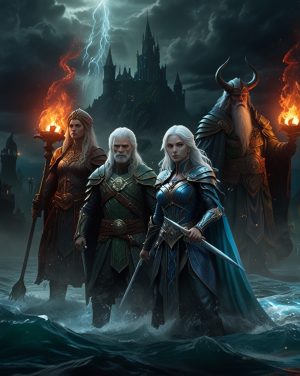
Creating a captivating fantasy world is a cornerstone of engaging storytelling. It allows readers to immerse themselves in realms where magic exists, mythical creatures roam, and epic adventures unfold. For authors, especially those aiming to promote their fantasy books, mastering the art of worldbuilding is essential. This guide explores the key elements and strategies to construct a fantasy world that not only enchants readers but also enhances the appeal of your literary works.
1. Establish Clear Rules and Systems
A believable fantasy world operates under its own set of rules and systems. Defining these parameters helps maintain internal consistency and allows readers to suspend disbelief.
- Magic System: Determine how magic functions. Who can wield it? What are its limitations and costs? For instance, in some worlds, magic may require incantations, while in others, it could be an innate ability.
- Societal Structure: Outline the hierarchy and governance. Is there a monarchy, a council of elders, or perhaps a democratic system? Understanding the political landscape adds depth to your world.
- Cultural Norms: Define traditions, customs, and taboos. These elements shape characters’ behaviors and societal interactions.
2. Develop a Rich History and Lore
A well-crafted backstory provides context and enriches the narrative.
- Historical Events: Create significant events such as wars, alliances, or discoveries that have shaped the current state of your world.
- Mythology and Legends: Incorporate tales of gods, heroes, and mythical creatures that influence contemporary beliefs and practices.
- Languages and Dialects: Even if not fully developed, having unique phrases or linguistic traits can add authenticity.
3. Design Diverse Geographies and Ecosystems
The physical landscape influences the story’s mood and characters’ lifestyles.
- Topography: Include varied terrains like mountains, forests, deserts, and oceans. Each setting offers unique challenges and opportunities for storytelling.
- Climate: Consider how weather patterns affect daily life. A harsh winter can symbolize adversity, while a blooming spring might represent renewal.
- Flora and Fauna: Populate your world with unique plants and animals, which can serve as resources, threats, or companions to your characters.
4. Create Multi-Dimensional Characters
Characters are the lens through which readers experience your world.
- Backgrounds: Develop detailed backstories that explain motivations, fears, and desires.
- Relationships: Map out connections between characters, including alliances, rivalries, and familial ties.
- Growth Arcs: Ensure characters evolve in response to the world’s events, making them relatable and dynamic.
5. Integrate Themes and Symbolism
Embedding deeper meanings can resonate with readers on multiple levels.
- Universal Themes: Explore concepts like good vs. evil, freedom, sacrifice, or destiny.
- Symbolic Elements: Use symbols, such as a recurring motif or a legendary artifact, to reinforce themes.
- Moral Dilemmas: Present situations that challenge characters’ ethics, adding complexity to the narrative.
6. Maintain Consistency and Continuity
A coherent world enhances believability.
- World Bible: Keep a comprehensive document detailing all aspects of your world to reference during writing.
- Maps and Schematics: Visual aids help maintain spatial awareness and prevent logistical errors.
- Timeline: Establish a chronological sequence of events to track historical and current happenings.
7. Engage the Senses
Vivid descriptions make the world tangible.
- Visual Details: Describe architecture, clothing, and landscapes with specificity.
- Sounds and Smells: Incorporate auditory and olfactory elements, like the bustling noise of a market or the scent of rain on soil.
- Textures and Tastes: Mention tactile sensations and flavors to enrich scenes, such as the roughness of a warrior’s hands or the sweetness of a local delicacy.
8. Reflect Real-World Issues
Parallels to actual societal concerns can add depth.
- Social Hierarchies: Address class systems, discrimination, or privilege within your world.
- Environmental Concerns: Explore themes like conservation, resource depletion, or natural disasters.
- Technological Advancements: Consider how innovations impact society, culture, and daily life.
9. Allow Room for Mystery
Not everything needs explanation; some ambiguity can intrigue readers.
- Uncharted Territories: Leave parts of your world unexplored, hinting at adventures beyond the current story.
- Ancient Mysteries: Introduce artifacts or ruins with unknown origins, sparking curiosity.
- Mythical Creatures: Feature beings shrouded in legend, their true nature open to interpretation.
10. Seek Feedback and Iterate
Refining your world enhances its richness.
- Beta Readers: Share your work with trusted individuals to gain insights into clarity and engagement.
- Writing Communities: Participate in groups where you can exchange ideas and receive constructive criticism.
- Continuous Learning: Study other fantasy works and worldbuilding resources to inspire and inform your process.
By meticulously crafting each aspect of your fantasy world, you create a setting that captivates readers and serves as a compelling backdrop for your narratives. This immersive environment not only enhances the reader’s experience but also elevates the appeal of your fantasy books, potentially boosting sales and expanding your audience.
Featured Book Recommendation
For readers seeking an enthralling fantasy adventure, consider exploring The Dark Keepers, a novel that masterfully exemplifies the principles of compelling worldbuilding discussed above. Dive into a universe where magic intertwines with destiny, and heroes are forged in the crucible of epic quests.